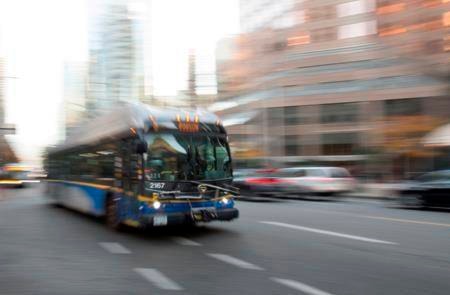The biggest news story in Metro Vancouver in recent weeks has concerned a transit operators’ strike that, as of Nov. 7, has had no effect other than to idle several SeaBus sailings between North Vancouver and Waterfront station in downtown Vancouver each day.
The union has threatened escalation, but its biggest success has been in planting fear in the minds of many who use the transit system.
READ MORE:
Transit use in Metro Vancouver is up substantially. For many people, a total shutdown would leave them with few alternatives. However, SkyTrain would likely keep running, because there are no drivers – one reason the Bill Bennett provincial government chose the technology in the early 1980s, when transit strikes were a much more regular occurrence.
The hot air about transit must seem amusing to residents in other parts of B.C., when thinking of their lack of transportation alternatives. BC Transit operates urban transit systems in most B.C. urban areas, but intercity transportation options are often minimal.
In some areas such as the West Kootenay, residents can travel between cities such as Trail, Castlegar and Nelson via BC Transit. In the South Okanagan, similar options are available.
There have also been improvements in northern B.C., with a service called BC Bus running twice a week between Fort St. John and Prince George, and Prince George and Prince Rupert. It runs once a week to Fort Nelson and Valemount.
Concerns about missing and murdered women along Highway 16, also known as the Highway of Tears, led to a concerted effort to offer more public transportation.
READ MORE:
It’s been a year since Greyhound left B.C. This left much of the province with few intercity transportation options, other than flying. A number of private bus operators have stepped up to help fill some of the gaps, notably between Vancouver and Calgary, Kamloops and Kelowna, and Kelowna and Nelson.
North of Highway 1 and in the East Kootenay, options are minimal, other than BC Bus. Perhaps a BC Bus-type system could be set up along the Highway 3, Highway 5 and Highway 97 corridors.
Another option rarely mentioned is passenger rail service. Service exists now between Vancouver, Kamloops, Jasper and Edmonton and also between Jasper, Prince George and Prince Rupert. It is operated by Via Rail Canada, which offers plenty of service in Ontario and Quebec, but very little in Western Canada.
The federal government funds Via Rail.
A modest expansion of existing train service (and perhaps a new Via route restoring the former BC Rail passenger service between Vancouver and Prince George) could provide a few more intercity options. The Cariboo region has few intercity options, and such a service could help.
The public seems unaware of the train option. Several years ago, we were on the Via train from Vancouver to Toronto, leaving Vancouver on a Friday night in February. The highway through the Fraser Canyon was closed because of snow conditions, but the trains were running. Yet most people trying to get to Kamloops or points between by bus thought they had no options – the train only had a few extra passengers.
Intercity transportation is important. That’s exactly why all levels of government need to do a better job in expanding transportation options to those not served, and to those who can’t afford airfare.
Frank Bucholtz is a columnist and former editor with Black Press Media. Email him at frank.bucholtz@blackpress.ca
Like us on and follow us on

.png;w=120;h=80;mode=crop)

